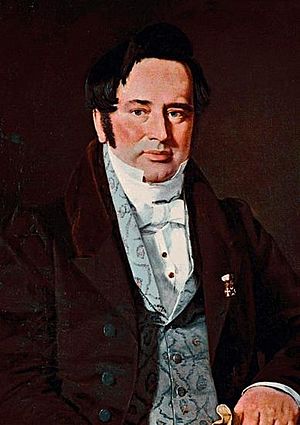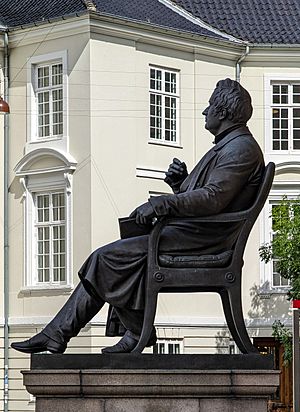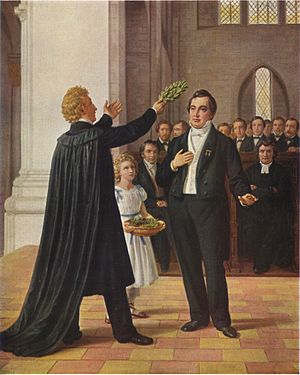Adam Oehlenschläger facts for kids
Quick facts for kids
Adam Gottlob Oehlenschläger
|
|
|---|---|

Portrait of Adam Oehlenschläger by Christian Albrecht Jensen (1825)
|
|
| Born | 14 November 1779 Copenhagen, Denmark |
| Died | 20 January 1850 (aged 70) Copenhagen, Denmark |
| Occupation | Poet, playwright |
| Nationality | Danish |
| Alma mater | University of Copenhagen |
| Notable works | Hakon Jarl hin Rige (1807) Axel og Valborg (1810) Nordens guder (1819) |
| Spouse | Christiane Georgine Elisabeth Heger (1782-1841) |
| Signature | |
Adam Gottlob Oehlenschläger (born November 14, 1779 – died January 20, 1850) was a famous Danish poet and writer of plays. He is known for bringing a new style called romanticism into Danish literature. He also wrote the words for the song Der er et yndigt land. This song is one of Denmark's national anthems.
Contents
Biography
Adam Gottlob Oehlenschläger was born in Vesterbro. This was a suburb of Copenhagen, Denmark. His father, Joachim Conrad Oehlenschläger, was an organ player at a church. Later, his father became the keeper of the royal palace. Adam's mother, Martha Marie Hansen, suffered from a serious illness.
Adam and his sister, Sophie Ørsted, learned to read and write at home. They were taught until they were twelve years old. When Adam was nine, he started writing poems easily. Three years later, a poet named Edvard Storm noticed him. This led to Adam learning about Scandinavian mythology.
In 1795, Adam finished his schooling. He was supposed to become a tradesman in Copenhagen. He also tried acting on stage. In 1797, he got small roles in several plays. But he soon realized he was not a good actor. A lawyer named Anders Sandøe Ørsted convinced him to leave the theatre. Anders later married Adam's sister, Sophie.
In 1800, Adam started studying at the University of Copenhagen. His studies were interrupted by his mother's death. He also spent a lot of time writing poetry. The First Battle of Copenhagen in 1801 also disturbed him. However, this battle inspired him to write a play called April the Second 1801. This was his first play.
In 1802, a young philosopher named Henrik Steffens returned to Copenhagen. He had visited Germany and was full of new romantic ideas. Steffens gave lectures at the university. He introduced Danish people to famous German writers like Goethe and Schiller. These lectures were very exciting. Steffens and Oehlenschläger met and talked for sixteen hours.
After their talk, Oehlenschläger went home. He immediately wrote his famous poem Guldhornene. This poem was written in a completely new style for Danish literature. His new ideas quickly led to a book of poems in 1803. This book is best known for the play called Sanct Hansaften-Spil.
Over the next two years, he wrote more great works. These included the epic poem Thors Reise til Jotunheim. He also wrote Langelandsreisen and the fantasy Aladdin (1805). By the age of twenty-six, Oehlenschläger was famous. Even people who didn't like the new romantic style recognized him. He was seen as Denmark's most important poet.
He then put his Poetical Writings into two books. The government gave him money to travel abroad. In 1805, he left Denmark for the first time. He joined Steffens at the University of Halle in Germany. There, he wrote his first major historical play, Hakon Jarl. He sent it to Copenhagen. Then he went to Berlin for the winter. He met important thinkers like Wilhelm von Humboldt and Johann Gottlieb Fichte. He also met Goethe for the first time.
In 1806, he visited Weimar and spent months with Goethe. He then stayed with Tieck in Dresden. In December, he moved to Paris. He lived there for eighteen months. During this time, he wrote three famous plays: Baldur hin Gode (1808), Palnatoke (1809), and Axel og Valborg (1810). Oehlenschläger also translated Aladdin into German. He added new parts that were not in the 1805 Danish version. This German version was published in 1808.
In 1808, he left Paris. He spent the autumn and winter in Switzerland. He was a guest of Madame de Staël at her famous salon. In 1809, Oehlenschläger went to Rome. He visited the sculptor Bertel Thorvaldsen. In Thorvaldsen's house, he wrote the play Correggio. He quickly returned to Denmark in 1810. He became a professor of aesthetics at the University of Copenhagen. He also married his long-time fiancée, the sister-in-law of Knud Lyne Rahbek.
His first university lectures were about a Danish writer named Johannes Ewald. His next lectures were about Schiller. From this time on, he wrote a lot. In 1811, he published the story Ali og Gulhyndi. In 1812, he published his last major play, Stærkodder.
From 1814 to 1819, his supporters argued with Jens Immanuel Baggesen. Baggesen represented an older style of writing. This argument seemed to bother Oehlenschläger and affect his writing. His best work during this time was a series of poems called Helge (1814). The play Hagbarth og Signe (1815) showed his writing was not as strong. In 1817, he returned to Paris. He published Hroars Saga and the play Fostbrødrene. In 1818, he was back in Copenhagen. He wrote the poem Den lille Hyrdedreng and the Edda-inspired poems called Nordens Guder.
His later works included the plays Erik og Abel (1820) and Væringerne i Miklagaard (1826). He also wrote the epic poem Hrolf Krake (1829). His last books were Tordenskjold (1833), Dronning Margrethe (1833), Sokrates (1835), Olaf den Hellige (1836), Knud den Store (1838), Dina (1842), Erik Glipping (1843), and Kiartan og Gudrun (1847). After he died, his memories were published in two books in 1850.
Personal life
Adam Oehlenschläger married Christiane Georgine Elisabeth Heger in 1810. She was the sister of Kamma Rahbek, who was married to Knud Lyne Rahbek. Oehlenschläger died on January 20, 1850. He was buried in the cemetery of Frederiksberg Church.
Legacy
Adam Oehlenschläger was a key figure in the romantic movement in Europe. Before 1870, no Danish writer had such a wide impact, except for Ludvig Holberg. His work made Danish people excited about their ancestors' poetry and religion. He wrote romantic plays that were very popular. His name is still connected with Scandinavian romance.
His earliest works are considered his best. His play Hakon Jarl is seen as his dramatic masterpiece. Even though he got ideas from Germany, he wrote more like English poets than German ones.
Honours
- In 1829, he was publicly honored in Lund Cathedral. He was called the "king of Nordic Poetry" and the "Scandinavian King of Song." This honor was given by Esaias Tegnér, a bishop.
- On his seventieth birthday, November 14, 1849, a public celebration was held for him. The king of Denmark gave him a special award, making him a Knight Grand Cross in the Order of the Dannebrog.
See also
 In Spanish: Adam Oehlenschläger para niños
In Spanish: Adam Oehlenschläger para niños




